We took a 1990’s guide to Vancouver sightseeing so we could get a sense of how much the city has changed. Follow this disjointed adventure as it unfolds, or learn more about the series HERE.
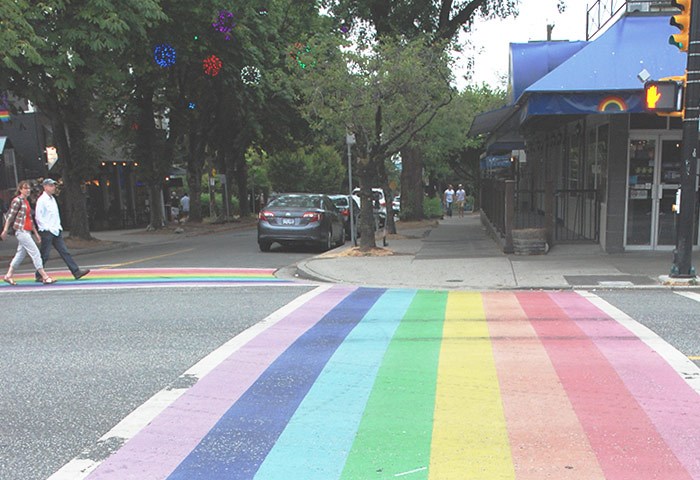 Probably the biggest cosmetic change to Vancouver’s West End are the rainbow tinted crosswalks.
Probably the biggest cosmetic change to Vancouver’s West End are the rainbow tinted crosswalks.
West End
Our first destination out of Stanley Park is the West End, tucked neatly into the shadow of Vancouver’s tallest buildings. Although it’s quiet at this early hour, the densely populated mix of residential dwellings and impressive strip of restaurants, pubs, bars, and clubs my guide describes sounds exactly like the West End of today.
“It’s a lively place to spend time,” the guide happily reports, slightly overcompensating for the lack of action on Davie Street at 6:30am. “Traditionally the West End was the area where gay men tended to live and play.”
POPULATION OF THE WEST END:
- 1999: 40, 000
- 2011: 44, 000
“No way, really?” I deadpan as we walk by a rainbow painted crosswalk, beside a pink garbage bin, complemented by a pink-polled bus stop. My need for a coffee is even more apparent than the City of Vancouver’s embracement of Davie Street as the epicentre of gay culture in British Columbia, but I’m not going to trust the task of getting caffeinated to 1999.
Instead, I head straight to JJ Bean on the corner of Bidwell and Davie. Even though I didn’t consult its wisdom for a cafe in the area, as we approach the unique, Spanish stylings of this relatively new JJ Bean location, my guide’s unavoidable purpose goes to work. It can’t be stopped. It must guide.
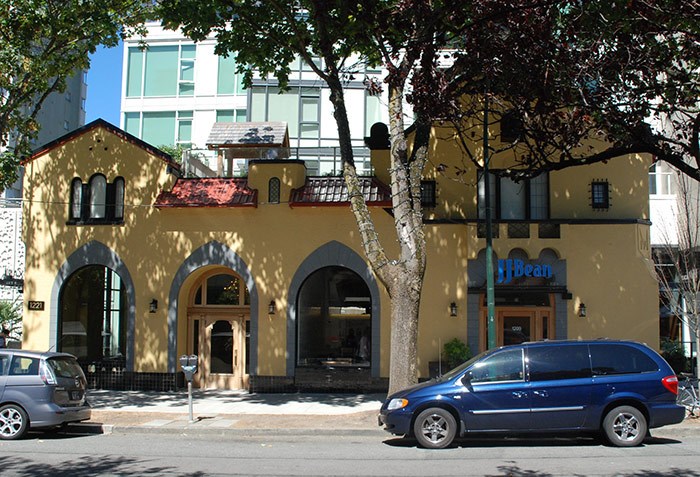 What was Mescalero’s in the 90s is now a JJ Bean.
What was Mescalero’s in the 90s is now a JJ Bean.
“Mescalero is a trendy combination of Spanish and Tex-Mex restaurant serving the usual assortment of items, plus paella, ostrich, and tapas.” I don’t bother correcting its understandable mistake since the building still looks like the monasterial class C heritage structure featured in the pages of my guide — except for the 21 story condominium that’s been dumped on its head.
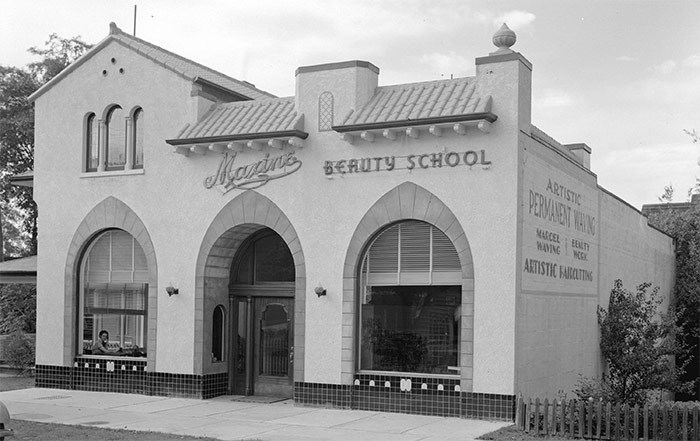
Originally built in the 1920’s, the JJ Bean occupying 1209 Bidwell is said to be haunted by its the associates of its original tenant, Madame Maxine McGillvary, owner of Maxine’s Beauty School.
The boarding house and beauty school has long-since been the source of illicit rumours that suggest it was the cover for a "gentlemen's club" involved with mob-connected rum-running to keep its stock of then illegal liquor flowing. No evidence has ever been found to suggest they actually existed, but two underground tunnels are said to have terminated under Maxine’s: one started where the English Bay bathhouse is currently located, making it easy to smuggle in the kind of contraband that makes for a good party; the second connected Maxine’s to the Gabriola Mansion, just up Davie Street.
B.T. Rogers, of Rogers Sugar fame, was the owner of the Gabriola Mansion during Maxine’s heyday, and he reportedly used a personally-built, red velvet lined tunnel for discreet visits to the “beauty school.”
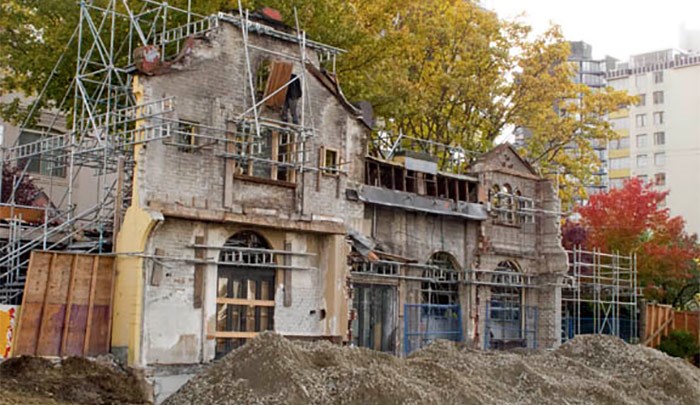
During the 90s, the Gabriola Mansion housed the Macaroni Grill. The familiar words bring my guide back to life as I swing open the door to JJ Bean, “Romano’s Macaroni Grill has a bag of tricks to bring in the business — including opera singers, cooking exhibitions, and pay-what-you-drink-jugs of...”
“Ok. Enough. I get it!” my un-coffeed, easily irritated response cuts short the helpful soliloquy it was about to launch into. The barista seems freaked out by my still-wearing-last-night’s-party looks and heated conversation with a book. Revealing my travel companion seems like the best way to ease the tension.
AVG. RENT FOR A 1 BDRM APARTMENT IN THE WEST END:
- 1999: $718.00
- 2015: $1250.00
“So I’m touring the city with this guide. It’s from the 90s. Apparently this place is haunted, have you seen or heard anything funny going on?” I say, completing my transaction.
“I’ve only been working here a month, so, uhm, not really.”
“Well, don’t be surprised if you do,” the much needed coffee warms my words with excitement, “It used to be a brothel. I can only imagine the stuff that went on in here!” I’m probably a bit too exuberant for a kid working an opening shift in a coffee shop, but his face lights up with interest, so I go on.
With my guide in hand beside me, I tell the tall tales of mob bosses, rum tunnels, "Madame" Maxine, and haunted lounges. I make it all sound really good, and not only has the rest of the staff joined in to listen, every customer in the cafe is listening to the story about JJ Bean’s mysterious past. Questions start coming, and my guide and I do our best to answer them. Suddenly, we’re a team! With caffeine in my veins, and the guide enjoying a newfound relevance, our exploration of the past has taken on a promising future.
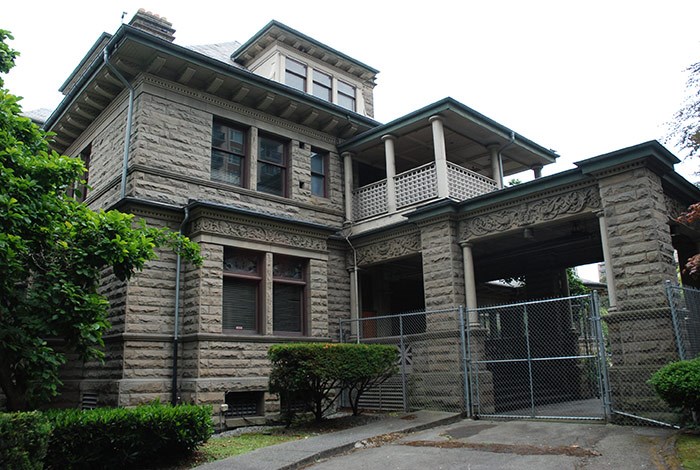 The guide’s beloved , Macaroni Grill awaits development.
The guide’s beloved , Macaroni Grill awaits development.
As we cut up Davie Street, the guide suggests some of the West End’s most popular gay bars, like Celebrities or Numbers, but it's too early. Instead, we stop outside the empty, cold, and abandoned mansion that was once the home of B.T. Rogers and Romano’s Macaroni Grill. I can’t help wonder what our taxidermic approach to heritage preservation will be created out of the condominium that will inevitably be built here. Will there be enough of a facade of the mansion left to remind us of B.T. Rogers traversing a red velvet tunnel by candlelight? Will the aura of camaraderie that seeped into the the walls of the Macaroni Grill by way of opera singers and pay-what-you-drink jugs of wine survive the historical lobotomy of new construction? Does it even matter? For answers, there is only one place I can turn.
“In the mid-1950’s, over the space of 13-years, 220 apartment buildings went up in the West End, and in so doing took away many of the fine old buildings that had made the West End a gracious place in which to live.” In an effort to hear comforting words from the past, my guide has instead described a West End that parallels my current lament — it always has been, and always will be, developing.
Learn more about the Guided By the 90s series on Vancouver Is Awesome.


